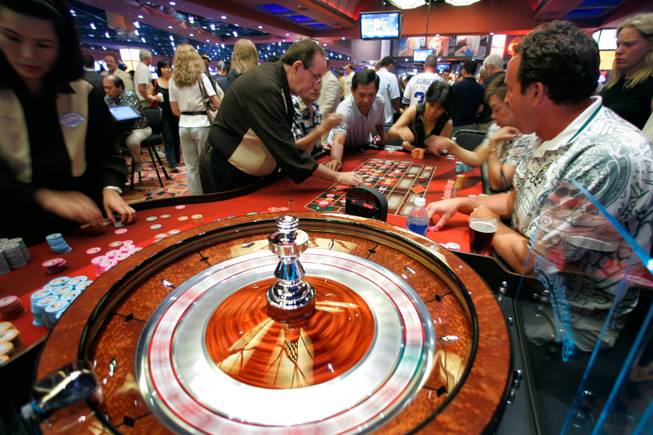Published Wednesday, May 9, 2012 | 8:30 a.m.
Updated Wednesday, May 9, 2012 | 11:04 a.m.
Sun coverage
The approval of online gaming wouldn’t negatively impact land-based casinos, the head of the industry’s largest association says.
Frank Fahrenkopf, president and CEO of the American Gaming Association, said if anything, the approval of Internet gambling would expand existing operations, because younger players more comfortable with online transactions would start gambling online and eventually find their way to local casinos.
“Because we’re talking about Internet poker at this time, I could see how offering it online might hurt a small casino that’s dependent on poker,” he said. “But we’ve spent significant time on is the impact of the Internet on existing operations, and our research concludes that it wouldn’t result in a significant change.”
Fahrenkopf made his remarks in a question-and-answer session following the release Wednesday of the Washington-based organization’s annual “State of the States: The AGA Survey of Casino Entertainment” report on commercial casino operations.
The report says the gaming industry is getting healthier nationwide with gross gaming revenue and tax revenue up at the 492 commercial casinos and 517 card rooms in the United States.
It’s the 14th AGA report comparing key casino data from the 15 states that have commercial casinos, 13 with so-called “racinos” at horse and dog tracks, 29 with tribal casinos and five allowing card rooms.
This year’s report says gross gaming revenue in 2011 was up 3 percent over 2010 to $35.6 billion. In the previous year, revenue increased by less than 1 percent. In 2007 and 2008, revenue declined as a result of the economic downturn.
This year’s edition also includes a survey of elected officials and civic leaders in gaming jurisdictions about the impact of casinos on their communities.
Tax revenue climbed 4.5 percent to $7.93 billion in 2011, and the industry directly employed 339,000 people who earned $12.9 billion in wages, tips and benefits. While the industry touts the number of jobs it provides, the total number of jobs in 2011 was down 0.4 percent from a year ago.
The report provides a comparative snapshot of commercial casinos and indicates that the Las Vegas Strip remains the top U.S. casino market with $6.07 billion in gross gaming revenue.
Three of the top 20 markets are in Nevada with Las Vegas’ Boulder Strip the No. 10 market ($778.9 million in revenue) and Reno-Sparks at No. 14 ($663.3 million).
The rest of the top 10: Atlantic City, N.J. ($3.32 billion); Chicago-area casinos in Illinois and Indiana ($1.93 billion); Detroit ($1.42 billion); Connecticut ($1.35 billion); St. Louis area in Missouri and Illinois ($1.11 billion); Philadelphia ($1.09 billion); Biloxi, Miss. ($824.8 million); and Tunica-Lula, Miss. ($817.1 million).
Community leaders were high on casinos as tax-revenue generators, job providers and tourism generators.
In the survey of 210 elected officials and civic leaders in counties with casinos, excluding Nevada, 83 percent said the impact of casinos on the community was positive and 88 percent said problems touted by casino opponents, such as crime and prostitution, never materialized.
Other highlights from this year’s report:
• Slot machines and video poker continued to be the casino game of choice, with 53 percent of players preferring those games, according to a survey of 800 people nationwide who visited casinos last year. Blackjack followed at 23 percent, poker at 7 percent and craps and roulette each at 3 percent.
• In the last 12 months, most people who gambled — 44 percent — bought lottery tickets. Casino gambling was second at 27 percent, followed by “casual betting” at 23 percent, playing poker at 15 percent, wagering on a race at 8 percent and Internet gambling at 4 percent.
• In the next 12 months, 39 percent of people said they would visit a casino one or two times, while 29 percent said they would go three to 10 times and 11 percent said they’d go more than 10 times. Eleven percent said they wouldn’t go at all, and 10 percent didn’t know or refused to answer.
• The study said 59.7 million people visited casinos in 2011 — more than a quarter of the nation’s population — and about a quarter of those didn’t gamble.
• Of those who went to a casino last year, 76 percent said they ate at a fine-dining restaurant, 62 percent said they saw a show, concert or other form of live entertainment, 51 percent said they went to a bar or club, 46 percent went shopping and 28 percent used a recreational facility like a spa, pool, fitness area or golf course.
• Maryland had the highest percentage increase in gross gaming revenue — 464.2 percent — because 2011 figures included casinos that were opened for a full year, compared with newly opened properties. Nevada’s gross gaming revenue was up 2.9 percent to $10.7 billion for the year.
• Five states showed declines in gaming revenue: New Jersey (7 percent), South Dakota (5 percent), Maine (3.6 percent), Delaware (3.3 percent) and Indiana (2.5 percent). Fahrenkopf said New Jersey’s decline was a result of increased competition from neighboring Pennsylvania, which, he said, could become the No. 2 state by gross gaming revenue by the end of this year, despite having the nation’s highest gaming tax rate at 55 percent.
• Nevada had the largest number of commercial casino jobs in 2011 — 174,381. Next was New Jersey with 32,823.
• Nevada continues to have the lowest gaming tax rate at 6.75 percent of gross gaming revenue with additional fees and levies imposed by county government.


Join the Discussion:
Check this out for a full explanation of our conversion to the LiveFyre commenting system and instructions on how to sign up for an account.
Full comments policy